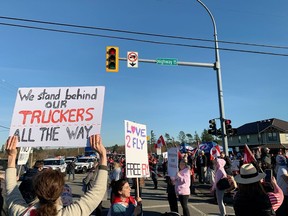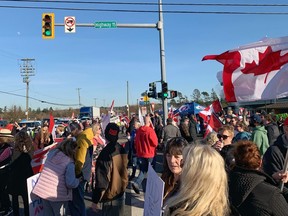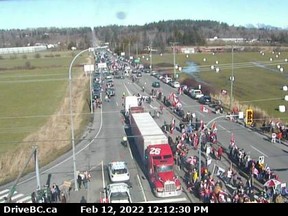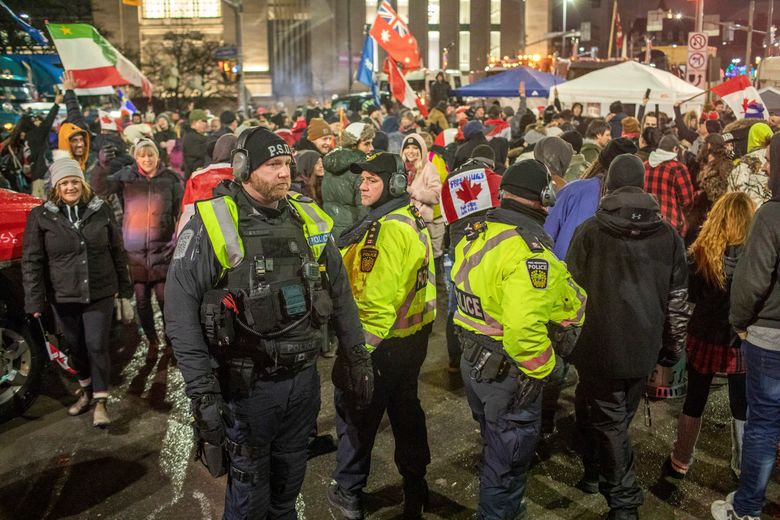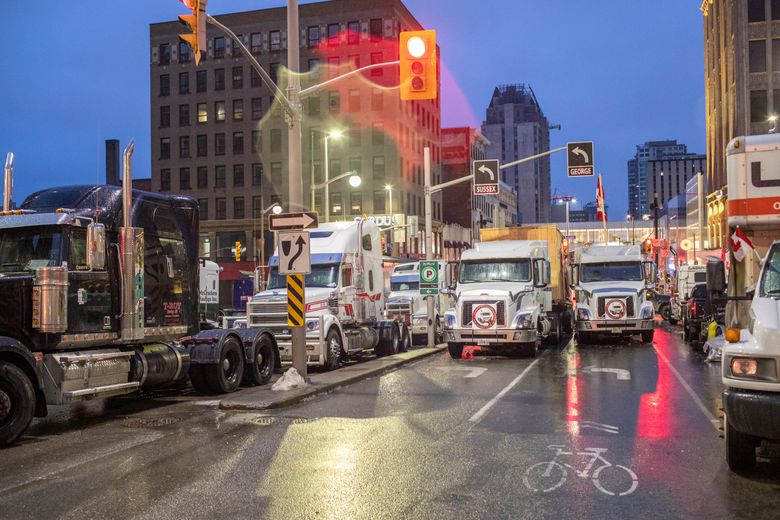Feb 12th, 2022,
The topic of the “Freedom Convoy” was handled somewhat differently on HBO’s Real Time Friday night than it has been by some other media outlets, with host Bill Maher and guests defending the protest as an expression of Democratic freedoms and urging leaders to “listen” to the protesters’ concerns.
Maher’s guests for the segment were author and former Biotech CEO Vivek Ramaswamy, and author and former Democratic presidential candidate Marianne Williamson, both of whom shared their support of peaceful protest, which phrase they emphasized includes the trucker convoy.
Maher began the segment by saying that, although at first he wasn’t too interested because it seemed like a “small group of people” and that it was only about specific vaccine mandates, it has since become more. He said the whole world is “looking at Canada,” and as the protest has grown it has become clear that “this is about something more than just the vaccine mandate.”
“It’s becoming a big thing. It’s happening all over the world now. They think it might happen here in Washington on Super Bowl Sunday,” said Maher. “Do you agree it’s about something more? And if so, what?”
Ramaswamy answered first, saying that it is about something more, calling it an “uprising” that reaches the whole of the democratic world.
“If you think this is about vaccine mandates or about white supremacy. You’re missing the point, he said. “And this isn’t a left or right issue. This is about an uprising of everyday citizens in democracies around the world.”
He said people are “rising against the biggest threat to actual democracy,” which he described as bureaucrats “crushing the will of everyday people.” He said the same class of people are also on corporate boards, head universities, and fill diplomatic posts.
“These are the unelected class of leaders that ultimately, I think, are using their bureaucratic power to supplant the will of everyday not only Americans, but Canadians and Western Europeans, too,” he said.
“That’s why we’re seeing a fusion of both the left and the right here, saying that actually, we want our voices heard. We want to be able to speak without fear of putting food on the dinner table,” he continued. “And you know what? The beautiful thing about a democracy is that so far, thank God, this has been a peaceful set of protests. I hope it stays that way. That’s part of the messiness of democracy. That’s part of what makes it beautiful.”
“You were ready for that one,” said Maher with a chuckle after the speech.
Williamson then answered, agreeing that “democracy is messy” and that this is the price of a free society.
“As long as we’re going to honor free expression, protest is important,” she said, “But also protest is inherently disruptive.”
“So the line we have to find for ourselves is where does disruption become harm?” she said, pointing out that the groups who suffer consequences of such disruptions have a voice, too. “These people have spoken, they have expressed themselves. They have a lot of passion behind their message, obviously. And what the Canadian government and any government has to then balance is, at what point does this now move over into more than your grievances, But the grievances of people such as workers in Detroit and elsewhere who are finding economic harm because of these protests?”
She then pointed out that the Canadian protest has been peaceful and that they managed to protest at Canada’s capital without storming into it, suggesting Americans might take a lesson.
At that point, Maher brought up the elitism aspect of the situation and the pandemic as a whole.
“Why truckers?” he wondered, and answered that, “You know, like during the pandemic, you know, I talked about this many times, you know, we would see these added, we’re all in it together. And I think: no, we’re not. No, we’re not.”
“There are some people who stay home and some people who bring them the food,” he said. “If you’re just ordering Amazon and you don’t ever have to go out and your job, you can do remotely. But who’s bringing the Amazon things? The trucker.”
“There is this idea, and it’s not wrong that some people are staying home in their Lululemons and other people are, and can afford to like, wait out and get a free vacation and money from the government, and other people can’t,” he said. “And they’re pissed off, the people who can’t.”
Ramaswamy agreed but added that there is also a difference in who gets listened to, arguing that leaders and corporations around the world jumped at the chance to listen to Black Lives Matter protesters. “I think those same institutional leaders would now do well to take a page from that playbook and listen to these truckers. I mean, listen to what they have to say.”
Maher then took a hard shot at Canada’s Justin Trudeau, reading aloud some of what Trudeau has said about unvaccinated Canadians.
“Now you do sound like Hitler,” Maher said in response to the quotes.
When Marianne Williamson expressed surprise that Trudeau had uttered such harsh remarks, Maher jokingly replied, “you didn’t see the blackface?”
HBO’s Real Time with Bill Maher.
'Just watch me': When Pierre Trudeau confronted the October Crisis
Reporter asked how far will the prime minister would go to keep people safe
Canada looked more like a police state than a democracy on Oct. 13, 1970.
Eight days earlier, a Quebec separatist group, the FLQ (Front de libération du Québec), had kidnapped British Trade Commissioner James Cross and Quebec cabinet minister Pierre Laporte.
By calling in army tanks and men in full gear, Prime Minister Pierre Trudeau's aim was to boost national security. But the military's presence made some Canadians feel a whole lot less secure.
"What is it with all these men and guns around here?" CBC reporter Tim Ralfe had asked Trudeau, amid a crowd of journalists waiting for him outside Parliament, in raw CBC footage showing Trudeau's discussion with reporters that day.
'Go on and bleed'
"Haven't you noticed?" Trudeau responded. "What's your worry?"
The exchange lasted several minutes more, with Trudeau defending his refusal to allow government ministers to be used as "tools of this blackmail" by the FLQ.
He said measures like soldiers on the streets would prevent further kidnappings, but Ralfe pushed back about "the kind of society that you live in."
"There's a lots of bleeding hearts around that don't like to see people with helmets and guns," said Trudeau. "All I can say is, go on and bleed. It's more important to keep law and order in this society than to be worried about weak-kneed people who don't like the looks of a soldier's helmet."
'How far would you go?'
Ralfe then asked Trudeau how far he would go to protect Canadians' safety during the crisis.
With a shrug, Trudeau replied: "Just watch me."
Three days later Trudeau invoked the War Measures Act, giving police the right to arrest and detain people on suspicion alone. The act was created in 1914 for cases of war or national emergency.
Trudeau also outlawed the FLQ and told police to arrest those with "extreme-left" literature, posters, stickers or pamphlets.




